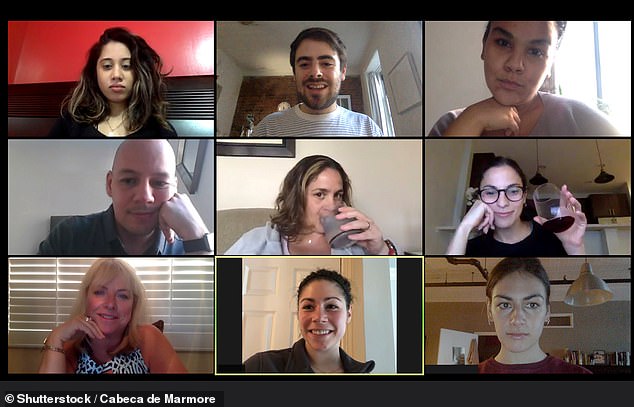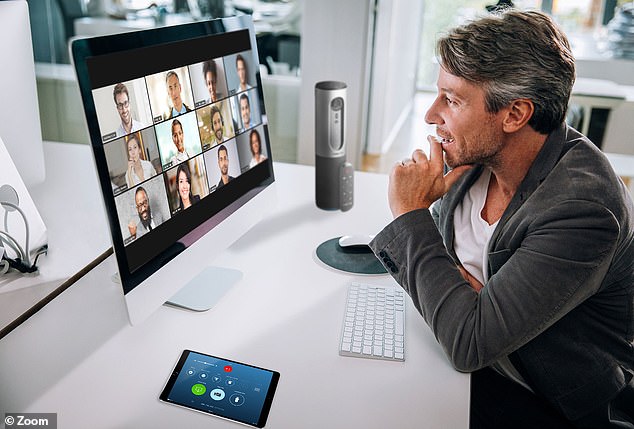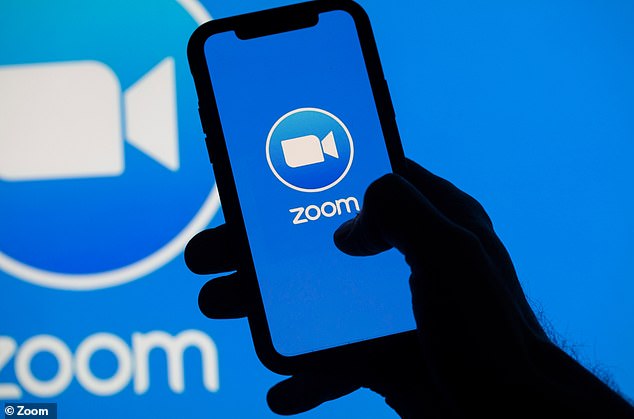Suffering from Zoom fatigue? Scientists reveal the surprising reason why your video calls are draining your energy—and the simple way to fix it
Do you ever feel exhausted and lethargic during video calls at work? Then a new study will be music to your ears.
Experts have revealed a simple tip that can help reduce “videoconferencing fatigue” – the feeling of exhaustion from sitting on Zoom for too long.
According to scientists in Singapore, it’s your choice of Zoom background that determines how tired you get.
If you use a blurred background or a moving video, you will get tired because the brain is overstimulated.
Instead, the experts recommend using a static image — or even no virtual background at all, as long as there isn’t much movement in it.
Spending hours on video calls can be tiring, manifesting as physical, emotional or cognitive fatigue – also known as ‘videoconferencing fatigue’ (file photo)

Videoconferencing surged in popularity during the Covid pandemic, when employees were forced to work from home – with grid-like displays like this a common sight. Even four years later, many companies are only just getting their employees back into the office, with many more still not planning to do so
The new research was conducted by researchers from Nanyang Technological University in Singapore and published in Boundaries in psychology.
They say hours of video calling can be tiring and can manifest as physical, emotional or cognitive fatigue – sometimes known as “videoconferencing fatigue.”
Ultimately, virtual video backgrounds – which show short videos that play automatically on a loop – proved to be the most tiring, they found.
“We show that using different types and contents of virtual backgrounds can contribute to videoconferencing fatigue,” said co-author Heng Zhang.
‘Users who use virtual video backgrounds experience more video conferencing fatigue than users who use images or blurry virtual backgrounds.’
Video conferencing tools like Zoom surged in popularity during the COVID pandemic, when employees were forced to work from home.
Even four years later, many companies are only just beginning to bring their employees back to the office, while many more have no plans to do so.
According to the study’s authors, videoconferencing remains an important part of modern life as people continue to work remotely and attend virtual events.

Zoom has become hugely popular during the coronavirus lockdown, as have other platforms such as WebEx, Microsoft Teams and Skype (archive photo)

According to Ofcom, Zoom went from 659,000 UK users in January 2020 to 13 million in April 2020
In their study, the experts wanted to investigate exactly how different types of virtual backgrounds influence fatigue during video conferencing.
She conducted a survey of 610 participants asking people whether they use virtual backgrounds and if so, what type: a static image, a blurry image, or a video.
The researchers measured videoconferencing fatigue using a five-point scale indicating levels of general, visual, social, motivational, and emotional fatigue.
The respondents consisted of 284 men and 326 women living in Singapore, aged 22 to 76 years, who worked from home approximately three days a week and eight hours a day.
The results showed that participants who used video backgrounds experienced the highest levels of videoconferencing fatigue.
People who used a blurred background also experienced greater fatigue during videoconferencing than people who used static images.
There was no significant difference between using a static image and no virtual background at all.
The researchers say our brains automatically respond to new information we can see in our environment, including the background of a Zoom call.
Video backgrounds in particular constantly introduce new information, constantly interrupting our attention and demanding ‘cognitive resources’.
‘For users of video backgrounds, the constant changes in the video mean new information is added with every frame,’ Zhang told MailOnline.

Zoom users can add any image to spice up their background, for fun or to hide the contents of their home from colleagues. The Maldives, pictured, is a popular destination for a Zoom background

A shot of the 1983 Doctor Who set from the BBC archive makes an excellent Zoom background option for ‘Whovians’
‘This continually disrupts their attention, consumes more cognitive resources and leads to higher levels of videoconferencing fatigue.
‘With blurred backgrounds, even though no entirely new information is being displayed, there may still be occasional glimpses of the real environment, providing new information.’
Interestingly, the environment depicted in the background can also influence videoconferencing fatigue.
Users with a nature theme reported lower levels of fatigue compared to users using office environments or public spaces.
According to Zhang, an office environment can “increase the pressure on the user to present themselves as if they were actually in one of those environments,” which can lead to fatigue.
According to Zhang and his colleague Benjamin Li, further research is now needed to investigate the role that other users’ backgrounds play in videoconferencing fatigue.
“A more comprehensive understanding of the role of virtual backgrounds in videoconferencing could provide more targeted recommendations for future research and practice,” Zhang added.
Of course, there are other factors that influence how tired you get from Zooming at work. Think about the specific aspects of your job, such as deadlines, the number of tasks, and the number of topics discussed.
A 2021 study titled “Zoom Fatigue and How to Avoid It” found multiple causes of Zoom fatigue, including reduced mobility, too much eye contact, and the “mirror effect” (having to see yourself on the screen).
Another study found that people who keep their cameras on during video calls feel more tired, with women experiencing this more often than men.
Another study during the Covid era found that people raise their voices due to blurry Zoom screens, possibly because they associate bad visuals with bad sound.
